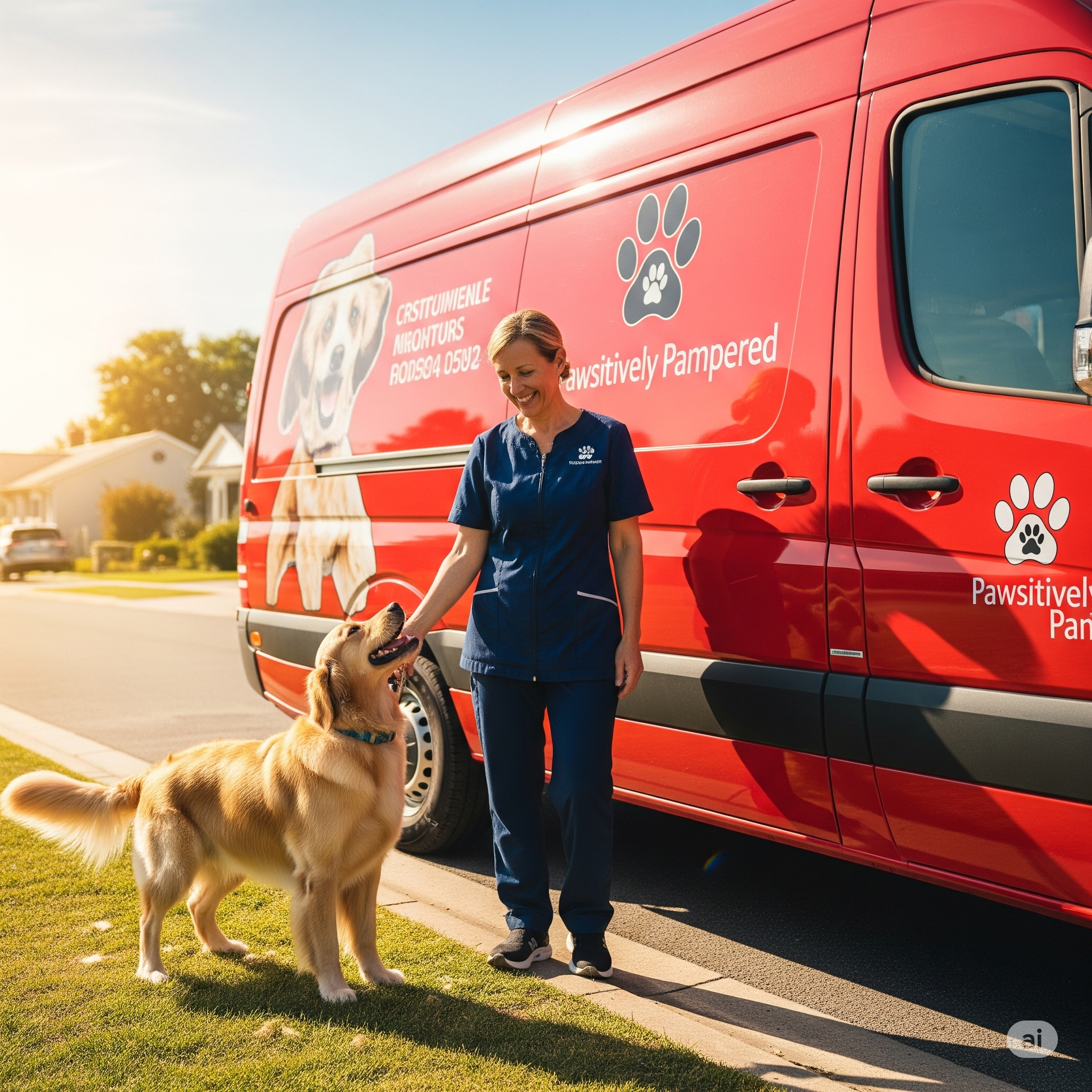Alright, let’s talk about a real game-changer in the world of entrepreneurship, a service that combines passion, practicality, and undeniable demand: launching a mobile dog grooming business. If you’ve ever found yourself daydreaming about building something truly your own, something that brings joy to both two-legged and four-legged clients, and something with serious profit potential, then you are absolutely in the right place. This isn’t just about giving Fido a bath; it’s about crafting a premier service, building a loyal clientele, and creating a thriving small business from the ground up, right in the heart of your community.
The conventional wisdom often pushes us towards brick-and-mortar storefronts, with all their associated rents, overheads, and geographical limitations. But savvy entrepreneurs, especially those looking at the modern landscape, are seeing the incredible advantages of mobility. Think about it: convenience is king. In our fast-paced world, people are constantly seeking services that come to them, saving time, hassle, and stress. For dog owners, this is a monumental relief. No more struggling to get a nervous pup into the car, no more waiting around in a crowded salon, no more exposure to other potentially sick animals. A mobile grooming service offers a private, stress-free, one-on-one experience right outside their home or office. This isn’t just a convenience; it’s a premium service, and premium services command premium prices, directly impacting your potential profitability as a small business owner.
My philosophy, and one I want to instill in you, is that every successful venture, no matter how humble its beginnings, starts with a rock-solid foundation of knowledge and a fearless dive into planning. We’re not just hoping for success; we’re building a strategic roadmap to achieve it. So, let’s peel back the layers and uncover precisely how you can transform this brilliant idea into a highly profitable reality.
The absolute first step, the one that often gets overlooked in the excitement of a new venture, is the creation of a comprehensive business plan. Now, I know what some of you might be thinking: “A business plan? That sounds like a lot of dry, corporate jargon!” And you’re not entirely wrong about the jargon part, but trust me when I say this document is far from dry. It’s your compass, your blueprint, your strategic guide through every twist and turn of launching and growing your small business. It forces you to think through every detail, anticipate challenges, and solidify your vision. It’s not just for securing loans; it’s for securing your own clarity and confidence.
Within this essential document, you’ll start with an Executive Summary. This is a concise overview of your entire plan, ideally written last, but placed first. It should highlight your business concept, your unique selling proposition, your target market, your financial projections, and your ultimate goals. Think of it as your elevator pitch, meticulously crafted.
Next, you’ll delve into the Company Description. Here, you’ll define your mobile dog grooming service: what you’ll offer, what makes you unique, and your mission and vision statements. Are you focused on luxury, eco-friendly grooming, speed, or specialized services for anxious dogs? This is where you articulate your unique value proposition. Why should clients choose your small business over another? This segment should clearly define your core values, the principles that will guide every decision you make, from hiring to customer service.
Then comes the critical Market Analysis. This is where you become a detective, uncovering the landscape of your potential client base and competition. Who are your ideal customers? Are they busy professionals in urban areas? Senior citizens with mobility issues? Pet owners in affluent suburbs who value convenience? You need to understand their demographics, their disposable income, and their pain points that your mobile service will solve. Simultaneously, you must meticulously research your competitors. Identify existing mobile groomers in your area, as well as established brick-and-mortar salons. What are their strengths? What are their weaknesses? Where are the gaps in the market that your small business can fill? Perhaps no one offers evening appointments, or specialized care for senior dogs, or a truly cage-free experience. Understanding the market size and its potential for growth is also paramount. Is the pet ownership rate increasing in your target community? Are people increasingly valuing premium pet services? These insights will profoundly shape your service offerings and marketing strategies.
Following this, outline your Services Offered. Beyond basic grooming, what specialized treatments will you provide? De-shedding services, breed-specific cuts, medicated baths, nail grinding, teeth cleaning, paw pad treatments, or perhaps even an express grooming package? Detail your proposed pricing structure. Will you charge per breed, per size, per hour, or offer package deals? Researching prevailing rates in your community is crucial here to ensure your prices are competitive yet profitable.
Your Marketing and Sales Strategy comes next. How will you reach your identified target market? We’ll dive deeper into this later, but for the business plan, lay out your initial ideas: a professional website, social media presence, local advertising, partnerships with veterinarians or pet stores, and referral programs. Every successful small business needs a robust plan to attract and retain customers.
Even if you’re starting as a solopreneer, your Management Team section is important. Highlight your relevant skills, experience, and any certifications you possess. If you plan to hire down the line, describe the roles you envision.
Finally, and this is where the “profitable” aspect really crystalizes, are your Financial Projections. This requires a deep dive into startup costs (your van, equipment, initial supplies, licenses, insurance), operating expenses (fuel, ongoing supplies, marketing, vehicle maintenance, software subscriptions), revenue projections (how many grooms per day/week, at what average price), and a break-even analysis (when will your revenue cover your costs?). This section is not just about numbers; it’s about translating your vision into tangible financial viability, demonstrating that your small business has the potential to thrive financially.
Now, with your robust business plan in hand, let’s move onto the nitty-gritty, the operational backbone of your mobile grooming empire. This is where the rubber meets the road, or more accurately, where the wheels hit the pavement.
One of your first practical decisions will be your legal structure. Will you operate as a Sole Proprietorship, a Limited Liability Company (LLC), or perhaps even an S-Corporation? Each has its own implications for liability, taxation, and administrative burden. For many small businesses starting out, an LLC offers a great balance of personal asset protection and operational simplicity. It separates your personal finances from your business finances, a crucial step for any serious entrepreneur. Consult with a legal and financial advisor to make the most informed decision for your specific circumstances.
Following this, you must navigate the world of business registration and licensing. This is not a step to skip or rush. You’ll likely need to register your business name at the state level, obtain a federal Employer Identification Number (EIN) even if you don’t initially have employees (it’s often required for banking and tax purposes), and secure various local permits and licenses. This could include a general business license, specific animal care or grooming permits, and potentially health department approvals. Regulations vary wildly by city and county, so meticulous research into your specific community’s requirements is absolutely essential. Don’t forget local zoning laws for where you might park your van overnight. Compliance isn’t just about avoiding fines; it’s about establishing legitimacy and trustworthiness for your small business.
Insurance is another non-negotiable. You cannot, under any circumstances, operate a mobile dog grooming service without comprehensive insurance coverage. This includes general liability insurance, which protects you if a dog gets injured in your care, or if a client claims property damage. You’ll also need vehicle insurance, specific commercial auto insurance rather than standard personal auto, to cover your grooming van. Equipment insurance is wise to protect your valuable tools from theft or damage. And if you plan to hire employees, workers’ compensation insurance will be mandatory. Think of insurance as a shield that protects your investment and your peace of mind, allowing you to focus on delivering exceptional service.
The heart of your mobile operation, of course, is the mobile grooming van or trailer itself. This is arguably your largest initial investment and requires careful consideration. You have a few options: purchasing a custom-built new van, buying a used one, or converting a standard commercial van yourself. Custom-built vans offer turnkey solutions, designed specifically for grooming, but come with a significant price tag. Used vans or DIY conversions can be more budget-friendly, but require more legwork and potential upfront renovation costs. Regardless of your choice, the van must be a self-contained unit. This means it needs fresh and grey water tanks (large enough for multiple grooms), a reliable water heater, robust air conditioning and heating for year-round comfort for both you and the dogs, excellent ventilation, and a dependable power source (usually a quiet generator or a powerful inverter system). You’ll also need a professional grooming table (often hydraulic or electric for ease of use and dog comfort), a purpose-built bathing tub, professional-grade dryers, and ample, secure storage for all your supplies and equipment. The professional upfitting of your van is critical for efficiency, safety, and creating a comfortable, hygienic environment. Remember, this is your mobile storefront, and its appearance and functionality reflect directly on the professionalism of your small business. Don’t underestimate the ongoing maintenance considerations for your vehicle; it’s the lifeblood of your service.
Once your van is ready, you’ll need to equip it. This means sourcing all your grooming tools and supplies. Think clippers, a variety of blades and shears for different coat types, professional shampoos and conditioners (consider eco-friendly or hypoallergenic options), high-quality towels, powerful force dryers and finishing dryers, brushes, combs, nail grinders, ear cleaning solutions, first-aid supplies for pets, and muzzles for safety. Investing in quality, durable tools pays off in the long run through efficiency and longevity. Research reliable suppliers who offer professional-grade products at wholesale prices. Building good relationships with these suppliers can lead to better pricing and timely deliveries, supporting the smooth operation of your small business.
Beyond the hardware and logistics, the core of your service is, naturally, the art of grooming itself and the unparalleled customer service you provide.
Let’s be brutally honest: you need to be a skilled groomer, or you need to become one. If you’re not already a professional groomer, enrolling in a reputable grooming academy or pursuing an apprenticeship is non-negotiable. This isn’t a hobby; it’s a profession that requires technical skill, knowledge of canine anatomy and behavior, and a deep understanding of different coat types and grooming techniques. Additionally, certifications in pet CPR and first aid are highly recommended. Accidents can happen, and being prepared could literally save a life, enhancing your credibility and ensuring the safety of the animals in your care. Your expertise is your primary product.
Your Service Menu and Pricing Strategy need to be well-defined. As discussed in the business plan, you’ll offer a range of services. But think beyond the basics. Can you offer premium add-ons that significantly boost profitability without adding excessive time? Think about de-shedding treatments, specialized facials, paw soaks, or “sparkle” packages. Consider tiered pricing structures (e.g., standard, deluxe, premium) to cater to different client needs and budgets. Loyalty programs, subscription models for regular grooms, or discounted multi-pet packages can also create recurring revenue and foster client loyalty. Always research local rates to ensure you are competitive, but don’t fall into the trap of underpricing your valuable, convenient, and personalized service. Your mobile convenience justifies a premium.
Efficiency in scheduling and route optimization will directly impact your profitability. Every minute spent driving between appointments is a minute you’re not earning revenue. Invest in good scheduling software that allows online booking and helps you map out the most efficient routes. Grouping appointments geographically can significantly reduce fuel costs and travel time, allowing you to fit more grooms into your day. This is a subtle but powerful lever for boosting your small business’s bottom line.
Client communication and management are paramount for building lasting relationships. Your booking process should be seamless and professional. Send automated reminders for appointments. Follow up after each groom to ensure satisfaction and solicit feedback. Learn how to handle difficult clients or challenging dogs with patience and professionalism. Building rapport and trust with both the pet owners and their beloved companions is the bedrock of repeat business and positive word-of-mouth referrals. Consider using a Customer Relationship Management (CRM) tool specifically designed for service businesses to keep track of client preferences, dog histories, and communication logs. This level of personalized service will set your small business apart.
Finally, safety protocols must be at the forefront of every operation. This includes safety for the dogs (secure restraints, proper handling techniques, monitoring for stress or health issues), safety for you (ergonomics, handling difficult dogs), and safety for your vehicle (regular maintenance, proper parking). Strict hygiene protocols are also crucial to prevent the spread of parasites or diseases. Disinfecting your tools and grooming area between every client is not just good practice; it’s a professional imperative.
With the operational machinery in place, the next vital component is letting the world know you exist and why they absolutely need your service. Marketing your mobile grooming small business is about strategic visibility and compelling communication.
Start with strong branding. This isn’t just a fancy logo; it’s the entire identity of your business. Choose a memorable name that resonates with pet owners and suggests convenience and quality. Design a professional logo that is clean, recognizable, and perhaps features a cute dog or a mobile element. Most importantly, invest in a high-quality vehicle wrap for your van. Your van is your biggest marketing asset, a moving billboard that will capture attention everywhere you go. A professional, eye-catching wrap that clearly displays your name, logo, services, and contact information is a phenomenal investment. Everything, from your business cards to your social media posts, should have a consistent, professional appearance that reflects the quality of your small business.
Your online presence is critical in today’s digital age. A professional, mobile-friendly website is essential. It should clearly outline your services, pricing, service area, and include a prominent call to action, ideally an online booking system. Feature high-quality photos of your van, your happy clients (with owner permission, of course!), and before-and-after grooming shots. Testimonials from satisfied customers are gold, so make sure they are prominently displayed. Beyond your website, embrace social media. Instagram is perfect for visual businesses like yours; showcase adorable before-and-after transformations, behind-the-scenes glimpses of your grooming process, and engaging content about pet care. Facebook can be used for community engagement, running local ads, and sharing updates. Crucially, set up and optimize your Google My Business profile. This is vital for local SEO; when people search for “mobile dog groomer near me,” you want to appear at the top. Actively solicit and respond to customer reviews on Google and other platforms; positive reviews are powerful social proof, boosting the credibility and visibility of your small business.
Beyond the digital realm, local marketing is equally powerful for a community-focused service. Create professional flyers and business cards to distribute in strategic locations. Partner with local businesses that cater to pet owners: veterinary clinics, pet supply stores, dog walkers, obedience trainers, and even local coffee shops that welcome dogs. Offer referral incentives to vets or pet store owners who send clients your way. Attend local community events, farmers’ markets, or dog park meetups. Set up a small booth to hand out business cards and engage with potential clients. Consider offering a small discount for first-time clients or for multiple pets in the same household. Develop a robust referral program for existing clients; offer them a discount or a free add-on service for every new client they refer. Word-of-mouth is the oldest and often the most effective form of marketing for a service-based small business, and an organized referral program supercharges it.
Finally, in marketing, reputation management is an ongoing process. Don’t just hope for good reviews; actively encourage them. After a successful groom, send a polite follow-up email or text asking clients to leave a review. And critically, respond to all feedback, both positive and negative, professionally and promptly. Address any concerns constructively and publicly demonstrate your commitment to customer satisfaction. Your reputation is your currency.
Let’s talk brass tacks: financial management and profitability. You’re starting a small business to earn a living, to build wealth, and to create something sustainable. Understanding your finances isn’t just about paying bills; it’s about strategically building a profitable enterprise.
Revisit your startup costs with a meticulous eye. This will include the purchase or conversion of your van, initial equipment (grooming tools, dryers, tubs), initial supplies (shampoos, conditioners, towels), licenses and permits, insurance premiums, initial marketing expenses (website, vehicle wrap), and any training you might need. Don’t forget a contingency fund for unexpected expenses. These are your upfront investments, and knowing this total number helps you understand your initial capital requirements.
Next, itemize your ongoing operating expenses. These are the costs you’ll incur regularly to keep your business running. Fuel will be a significant cost for a mobile business. Vehicle maintenance and repairs are inevitable. Ongoing supplies (shampoos, towels, blades) will be a recurring expense. Insurance premiums, software subscriptions (for scheduling, CRM, accounting), marketing costs, and any wages if you hire staff later on. Track these expenses diligently; every dollar counts when building a profitable small business.
Crucially, you must price for profit. This means understanding your costs per groom. Calculate your variable costs (supplies per groom, fuel for that specific trip) and allocate a portion of your fixed costs (insurance, software, van depreciation) to each service. Once you know your cost, you can then add your desired profit margin. Don’t fall into the trap of underpricing because you’re new or because you’re worried about competition. Your mobile service offers immense value and convenience, and your pricing should reflect that. Analyze what your time is worth and ensure your rates align with your financial goals.
To keep a firm grip on your finances, invest in good accounting software. QuickBooks or Xero are excellent options that allow you to track income, expenses, generate reports, and manage invoicing. Absolutely, without exception, open a separate business bank account and use it exclusively for all business transactions. This simplifies accounting, tax preparation, and maintains a clear distinction between your personal and business finances, a hallmark of a well-run small business.
Cash flow management is vital. Even a profitable business can run into trouble if it doesn’t have enough cash on hand to cover immediate expenses. Keep a close eye on money coming in versus money going out. Understand your payment terms with clients (are they paying upfront, or after service?) and your payment terms with suppliers.
Identify Key Performance Indicators (KPIs) to monitor the health and growth of your business. This could include the number of grooms per day or week, your average service price, customer acquisition cost (how much does it cost you to get a new client?), and customer retention rate (how many clients come back?). Tracking these numbers will give you clear insights into what’s working and what needs adjustment.
To consistently boost profitability, implement strategies beyond just increasing prices. Promote your high-margin add-on services aggressively. Develop premium packages that offer greater value at a higher price point. Refine your route planning to minimize non-billable drive time. Manage your inventory of supplies effectively to avoid waste and overstocking. Consider offering subscription packages for regular grooming, ensuring consistent recurring revenue. Each of these strategies, big or small, contributes to the overall financial health of your small business.
Looking beyond the initial launch, envision the growth and scaling of your mobile grooming empire. What does success look like a few years down the line?
Perhaps your first major growth step will be hiring your first employee. This is a significant milestone for any small business owner. When is the right time? When demand consistently outstrips your capacity. How do you do it? Start by finding skilled, trustworthy groomers who share your passion for animals and your commitment to exceptional customer service. Develop a clear training program and consistent grooming protocols to ensure quality control across your brand.
As demand continues to grow, you might consider adding more vans to your fleet. This allows you to expand your service area, serve more clients, and dramatically increase your revenue potential. Each additional van represents a significant investment, but it also represents a tangible expansion of your small business’s footprint and capacity.
While perhaps a distant dream for now, the potential for franchising your successful mobile grooming model could even be on the horizon. Imagine your brand, your van design, and your operational systems being replicated by other entrepreneurs across the country.
You could also consider diversifying your services, though it’s generally wise to master mobile grooming first. Perhaps adding specialized pet sitting for your grooming clients, or offering a premium dog walking service. However, for initial profitability, focus and excellence in your core offering will be key.
Ultimately, successful entrepreneurs are never truly “done.” The market evolves, client needs change, and new techniques emerge. Continuous improvement is not just a buzzword; it’s a practice. Stay updated on the latest grooming techniques, pet care trends, and business management strategies. Attend industry conferences, read trade publications, and network with other pet business professionals. This commitment to ongoing learning and adaptation will ensure your small business remains competitive, relevant, and consistently profitable for years to come.
Launching a profitable mobile dog grooming service in your community is more than just starting a business; it’s about realizing a dream. It’s about combining your love for animals with sound business principles, delivering unparalleled convenience, and building a reputable, beloved brand. It demands hard work, meticulous planning, and a genuine passion for what you do. But the rewards, both financial and personal, are immense: the satisfaction of being your own boss, the joy of working with animals, and the pride of building a thriving small business that genuinely serves and enriches your community. So, take that leap, arm yourself with knowledge, and get ready to roll out a service that will have tails wagging all over town. Your journey to entrepreneurial success starts now.



